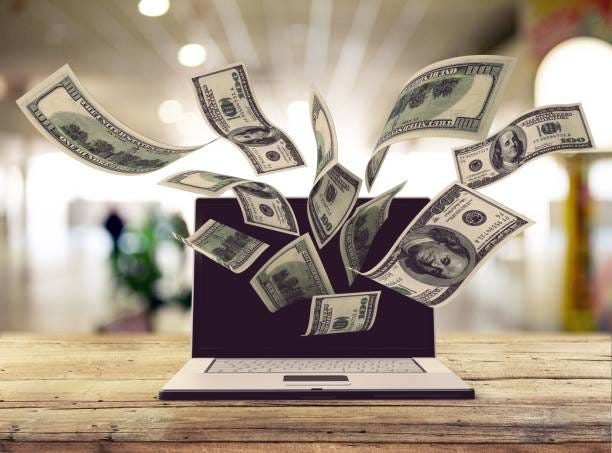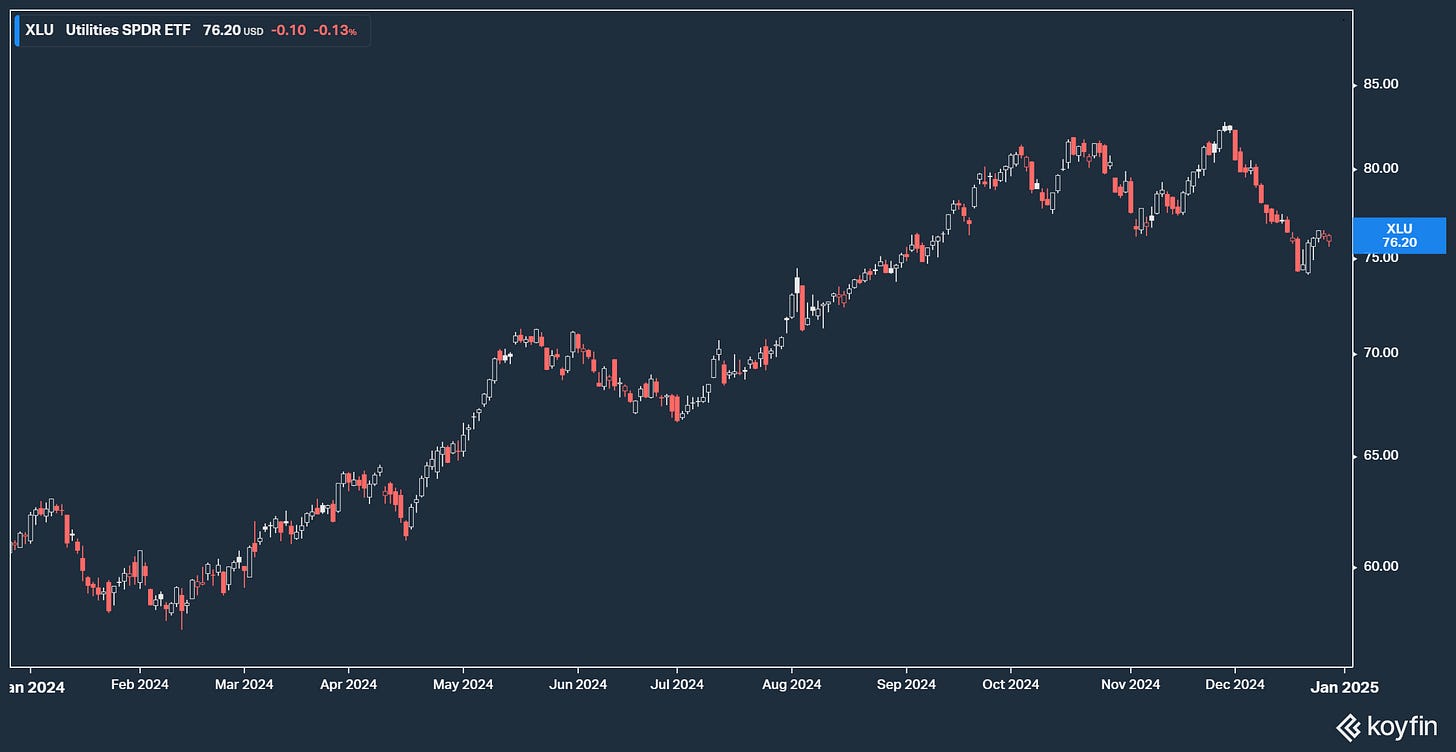2024 Was A Good Year For Income Investing, 2025 Will Be Better
And lower interest rates are only one reason why.
Welcome to my last regular Dividends with Roger Conrad post for 2024. I hope everyone in our Dividends Community is having a great holiday season!
If you’ve enjoyed my column the year, I cordially invite you to start out 2025 right by checking out my Dividends Premium service. It also features Dividends Premium REITs and exclusive 24/7 access to the Dividends Roundtable, the forum for ongoing discussion of all things investment I host on the Discord application.
Check out the upgrade options highlighted in this email and the Substack application, including our end-year discount. Here’s to a very happy and prosperous New Year!—RC
At least on the surface, 2024 was another year of triumph for Wall Street’s High Tech leaders. In fact, the popular perception is they more or less left the rest of the stock market in the dust.
The artificial intelligence revolution firmly captured the public’s imagination. And despite emerging political and technical challenges including an insatiable demand for energy, AI’s leading companies treated investors to monster stock market gains—for example, Nvidia Corp (NSDQ: NVDA) at 175% plus year-to-date.
With just two trading days left in 2024, the largest Big Tech stocks dominate the S&P 500 as thoroughly as they did at the end of 1999, with the so-called “Magnificent 7” a combined 34%. Apple Inc (NSDQ: AAPL) alone is 7.63% of the index—and therefore the trillions of dollars of ETFs, Target funds and other giant pools of capital that in turn make up the bulk of Americans’ retirement savings.
The four largest sectors in the S&P 500 right now are Semiconductors (11.63%), Software (10.57%), Technology Hardware/Storage (7.98%) and Interactive Media (6.69%). That’s nearly 37% combined, compared to just 3.33% for the Banks and 2.8% for Oil and Gas—both actually much larger sectors by revenue.
Tech’s massive and historically high share of investment dollars compares to close to record low ownership of dividend stocks. For example, Utilities and other Power generation companies—without which the AI revolution would be impossible—weigh in at just 2.2%. Telecoms are just 0.66%. And after weakening into the end of the year, Real Estate Investment Trusts are just 1.9%.
Dividend stocks in other words still aren’t feeling much love from investors. Yet, 2024 was anything but a losing year.
The Utilities Select SPDR Trust (XLU), for example, looks set to exit with a total return close to 25%. That’s only a couple percentage points behind the SPDR S&P 500 ETF Trust (SPY). And it’s roughly even with the Tech Sector SPDR ETF (XLK), half of which is in just four Big Tech stocks.
2024 wasn’t quite as kind to other dividend stocks. The broad-based iShares Select Dividend ETF’s (DVY) 17% return is still well behind the S&P 500. And after plunging more than -10% this month, the Real Estate SPDR ETF’s (XLRE) is barely in the black.
Volatility was greater than usual this year. That was hardly a surprise given the wild swings in investor expectations for Federal Reserve actions/inaction. The uneven impact of China’s economic stimulus to date has added to doubts about the health of the global economy.
And political uncertainty is running hot globally following results of US elections, the fall of two French governments in one year, growing calls to oust Canadian Prime Minister Trudeau, the overthrow of Syria’s defacto royal family and the impeachment of South Korea’s president following his attempt to order martial law.
Clearly, we live in interesting times. And there’s nothing historically that investors have preferred less. But through all of that, 2024 has still been a positive year for dividend stocks overall. And that includes the recommendations in the Dividends Premium and Dividends Premium REITs model portfolios.
The push of the positives was greater than the pull of the highly publicized negatives.
Front and center for 2024 was the economy. After soaring for two years following the pandemic, prices of essential items like groceries didn’t drop. But they did stop rising, bringing inflation down sharply without triggering a major economic contraction.
That prevented a meaningful retreat for stocks, despite the Big Tech leaders being arguably already priced for perfection and therefore especially vulnerable to disappointment. And it eventually convinced a reactive Federal Reserve to pivot from raising to cutting the Federal Funds rate.
Fed Chairman Jerome Powell’s forecast of just two rate cuts in 2025 was obviously a huge disappointment to many investors. And the result was a mass exodus out of stocks, particularly companies considered the most interest rate sensitive including REITs.
Nonetheless, the benchmark Fed Funds rate will end this year a full percentage point lower than it ended 2023. Borrowing costs are still well above where they were in early 2022. But investment grade companies are now issuing bonds at rates on par with early 2023. And after spiking the past couple years, quarterly debt interest costs are leveling off.
Debt finance for expansion and acquisitions is no longer toxic. Companies are still avoiding new issuance when they can. But the strong are again seeing solid demand for their bonds at manageable rates when they come to market.
The history of this Fed shows it will only cut rates again when one of two things happens. The benign case is inflation moderates enough for the central bank to feel safe cutting. The less savory one is the stock market weakens unexpectedly and dramatically. And the Fed swings into action to prop up the economy, even with their preferred inflation gauge still higher than they’d like.
In my view, there’s more than enough risk of a meaningful stock market downturn next year for income investors to build a cash reserve now—we have roughly 20% in the Dividends Premium portfolio.
Holding that much cash is not a long-term strategy. Cash only loses value to inflation over time. But being a little liquid in an extremely top-heavy market that’s increasingly vulnerable to wild momentum swings is valuable not just as a wealth preserver against a crash. It’s your surest source of funds for picking up bargains at any time. And though money market yields have dropped about a percentage points from their peaks, they’re still quite competitive with most stocks and even bonds.
But the larger point is regardless of how fast the Fed moves this year, the direction of interest rates will still be down. And that means the biggest headwind for dividend stocks the past three years is now a tailwind, which will only gain in strength in 2025 and beyond.
The main counterargument since the November election has been that Trump Administration policies will force the Fed to recalibrate. And judging from the late year selloff in many dividend stocks, the central bank’s mid-December announcement it will “go slow” with future cuts obviously confirmed that for many.
But by late spring, I expect most of the sellers will have reversed field. And their “buy back in” prices are likely to be somewhat higher than where the stocks they sold are trading now.
First off—with respect to all those who do politics for a living—the November 2024 election didn’t really deliver a mandate for anything. The president-elect did win one of the more impressive tactical elections in memory. But he also fell short of capturing a majority of votes cast. And he’ll take office with Republicans holding an effective one-vote majority in the fractured House of Representatives, pending three special elections this spring.
There’s been no shortage of commentary on the scramble to avoid a pre-Christmas government shutdown. But however you come down politically, there’s one clear takeaway: It’s going to be very difficult to get anything through Congress next year that doesn’t capture meaningful votes from both Democrats and Republicans.
That basically rules out 99% of what people are talking about on social media. President Trump will hold enormous power over the federal bureaucracy. But there’s no reason to expect he’ll do anything that would up-end the investment markets—any more than he did in his first quite investor-friendly term. And policies that threaten to ignite inflation certainly would.
Bottom line: There will be actions taken that greatly affect certain industries like healthcare and energy. But politics won’t affect investment returns nearly as much as big (and small) financial media appear to imagine now.
That’s very good news for stocks of most dividend paying companies. And by spring, any “Trump trade” selling is likely to be well reversed and then some for the best in class.
As for sectors, utilities, REITs, healthcare/biotech, renewable energy and oil and gas are all great candidates for big gains as politics-based fears fade. And we may see a generous cut in tax rates as well.




